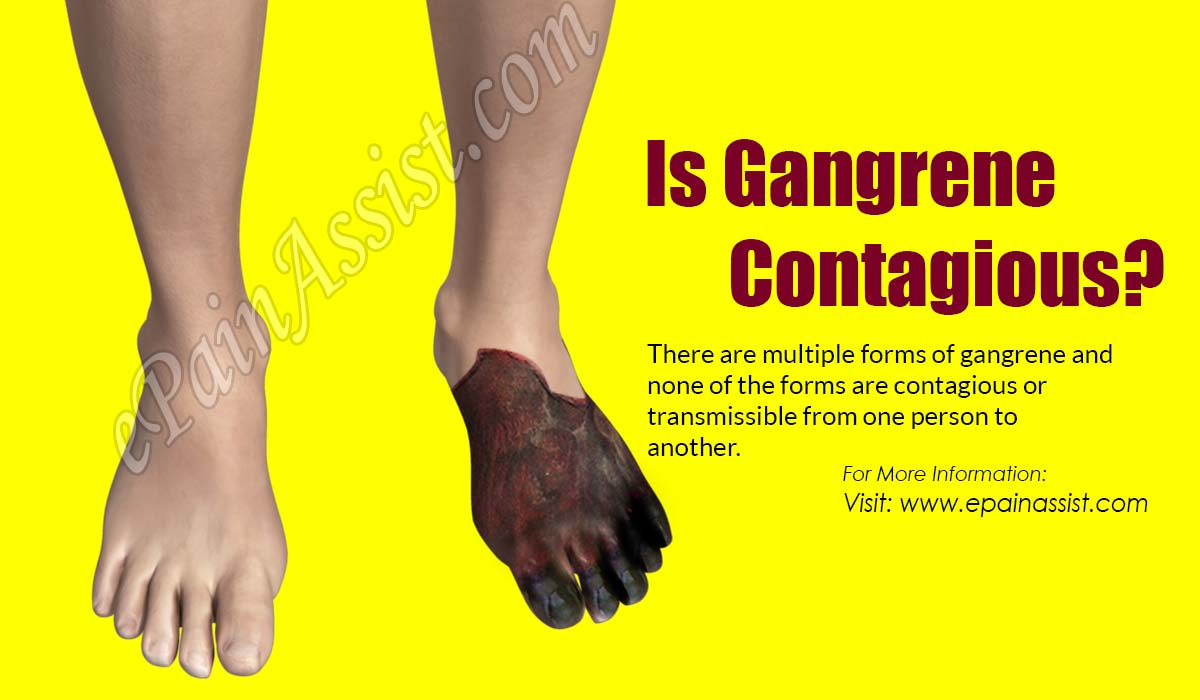Gangrene is a medical term used to describe death or necrosis of tissues in a localized area due to poor blood supply in the affected area. It is commonly caused by infection from bacteria found in soil. Gangrene is classified into 2 major categories: Dry Gangrene and Wet Gangrene. The most commonly affected sites of gangrene are extremities which include toes, fingers, hands, arms, feet and legs. Gangrene is a life threatening condition and should be treated immediately surgically (amputation or debridement) and appropriate medications should be advised.

Is Gangrene Contagious?
There are multiple forms of gangrene and none of the forms are contagious or transmissible from one person to another. However, it has been noted that poor infection control can lead to spread of gangrene and worsening of existing condition. For example, improper sterilizations technique and infection control (via contaminated surgical instruments and gloves) can lead to cross contaminations. This can cause transmission of bacteria or other pathogens from one patient to another. Gangrene does not transmit from one person to another naturally and thus there is no need for isolation or quarantine. The infectious agent is contagious but gangrene as such is not contagious. In mass infection and emergency situations, patients infected with similar organisms are often grouped together for efficient management and treatment.
How Fast Can Gangrene Spread?
The time taken by gangrene to spread depends on the type of gangrene and the cause of the condition.
Wet Gangrene: Wet gangrene is also called as moist gangrene. It is one of the most dangerous forms of gangrene which spreads rapidly and if left untreated, it can lead to sepsis followed by death within few hours to days. This condition occurs when there is complete or partial reduction of blood flow to an area along with bacterial infection in the area.
Dry Gangrene: Dry gangrene is less dangerous than wet gangrene and may not be associated with infection. There is a localized tissue death followed by sloughing off. The progression or the time taken for a dry gangrene to spread is much slower than wet gangrene and takes days to months to progress from one stage to another. However, in some cases, there may be secondary infection and the condition may develop into wet gangrene. In such cases, the spread of the condition is much faster. In few cases, dry gangrene may develop within few hours or days, if the blood supply to the area is completely occluded suddenly.
Gas Gangrene: Gas gangrene is very rare but at the same time very dangerous and requires immediate medical attention. It is generally caused due to trauma followed by clostridia infection leading to accumulation of toxic gas within the tissue. If left untreated this condition can be fatal in 48 hours.
Meleney’s Gangrene: This is also known as progressive bacterial synergistic gangrene. It is a rare type of gangrene and it typically occurs after a surgery. Painful lesions associated with this condition develop about 2 weeks post-surgery.
Other risk factor which may accelerate the progression of gangrene includes:
- Atherosclerosis
- Diabetes
- Smoking
- Trauma or serious injury
- Peripheral arterial diseases
- Obesity
- Raynaud’s disease
- Weak immune system.
Also Read:
- Necrotizing Fasciitis: Risk Factors, Causes, Signs & Symptoms, is it Contagious, Treatment, Prevention
- What Causes Gangrene? Know its Symptoms and Treatment
- Diabetic Gangrene: Why Do People With Diabetes Get Gangrene & How Is It Treated?
- What are the Types Of Gangrene?
- What is Fournier’s Gangrene & How is it Treated?|Causes, Symptoms, Prognosis, Prevalence of Fournier’s Gangrene
